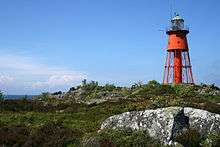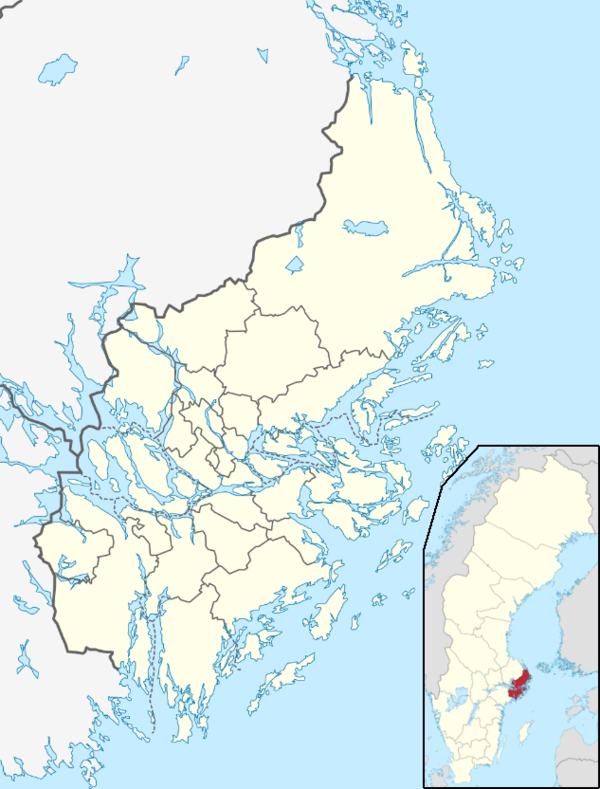Svenska Högarna
 Svenska Högarna Lighthouse | |
 Stockholm Region | |
| Location |
Svenska Högarna Stockholm Archipelago Sweden |
|---|---|
| Coordinates | 59°26′38″N 19°30′07″E / 59.443807°N 19.501813°ECoordinates: 59°26′38″N 19°30′07″E / 59.443807°N 19.501813°E |
| Year first constructed | 1874 |
| Automated | 1966 |
| Foundation | stone |
| Construction | cast iron tower |
| Tower shape | conical skeletal tower with central cylinder, onservation room. balcony and lantern |
| Markings / pattern | red tower, greenish metallic lantern dome |
| Height | 18 metres (59 ft) |
| Focal height | 31 metres (102 ft) |
| Original lens | 2nd order Fresnel lens |
| Current lens | 4th order lens |
| Range | 15 nautical miles (28 km; 17 mi) |
| Characteristic | LFl W 15s. |
| Admiralty number | C6460 |
| NGA number | 9968 |
| ARLHS number | SWE-066 |
| Sweden number | SV-2800 |
| Managing agent | Swedish Maritime Administration (Sjöfartsverket)[1] |
Svenska Högarna (en: The Swedish Hillocks) is a small group of islands and a lighthouse located east of Möja in the Stockholm archipelago.
History
The lighthouse is located on the largest island Storön, and is the only lighthouse in Stockholm archipelago with the classic iron design of architect Nils Gustaf von Heidenstam. Before the lighthouse was built there had been a checkered day beacon on the island, it is now located at the island of Storkläppen in Östergötland. Svenska Högarna lighthouse was lit in 1874 with a colza oil lamp. In 1887 a paraffin lamp was installed, in 1966 it was electrified and in 1986 solar cells were put in use to generate power.
The island is staffed with a weather station. It is frequently reported as a wind observation station in the Shipping Forecast of the Swedish Meteorological and Hydrological Institute. Since 1994 the lighthouse is owned by a foundation called "Edward Sjöbloms stiftelse". All of the islands are a nature reserve with sparse vegetation. On the islands you can also observe two giant's kettles. There is no scheduled traffic to Svenska Högarna. Access is by own boat or taxiboat. The isolated islands are not easy to reach: the weather must be very calm in order to moor boats safely to the rocky shores.
Climate
Svenska Högarna has an oceanic climate with low diurnal temperature variation, windy and mild conditions. Summer highs are cool, whilst winter lows remain very mild, with some years barely having a meteorological winter. The climate has a significant seasonal lag, with temperature extremes often being two months after maximum and minimum insolation. The climate is relatively dry in terms of rain and snowfall, but retains a high humidity. In spite of its isolated position, the climate has semi-continental characteristics, with significant differences between seasons for such an isolated island.
| Climate data for Svenska Högarna (2002-2015; precipitation 1961-1990; extremes since 1901) | |||||||||||||
|---|---|---|---|---|---|---|---|---|---|---|---|---|---|
| Month | Jan | Feb | Mar | Apr | May | Jun | Jul | Aug | Sep | Oct | Nov | Dec | Year |
| Record high °C (°F) | 8.4 (47.1) |
8.1 (46.6) |
11.0 (51.8) |
15.7 (60.3) |
21.8 (71.2) |
26.0 (78.8) |
28.2 (82.8) |
29.3 (84.7) |
22.8 (73) |
16.6 (61.9) |
11.9 (53.4) |
9.9 (49.8) |
29.3 (84.7) |
| Average high °C (°F) | 1.1 (34) |
0.6 (33.1) |
2.4 (36.3) |
6.3 (43.3) |
10.8 (51.4) |
15.8 (60.4) |
20.3 (68.5) |
20.2 (68.4) |
15.5 (59.9) |
10.0 (50) |
6.1 (43) |
3.3 (37.9) |
9.3 (48.7) |
| Daily mean °C (°F) | −0.2 (31.6) |
−0.8 (30.6) |
0.8 (33.4) |
4.1 (39.4) |
8.4 (47.1) |
13.3 (55.9) |
17.9 (64.2) |
18.0 (64.4) |
13.7 (56.7) |
8.5 (47.3) |
4.7 (40.5) |
1.8 (35.2) |
7.5 (45.5) |
| Average low °C (°F) | −1.6 (29.1) |
−2.2 (28) |
−0.8 (30.6) |
1.9 (35.4) |
6.0 (42.8) |
10.7 (51.3) |
15.5 (59.9) |
15.8 (60.4) |
11.8 (53.2) |
7.0 (44.6) |
3.4 (38.1) |
0.4 (32.7) |
5.6 (42.1) |
| Record low °C (°F) | −24.6 (−12.3) |
−23.4 (−10.1) |
−24.0 (−11.2) |
−15.3 (4.5) |
−1.9 (28.6) |
3.0 (37.4) |
7.2 (45) |
8.0 (46.4) |
2.9 (37.2) |
−2.7 (27.1) |
−9.0 (15.8) |
−14.8 (5.4) |
−24.6 (−12.3) |
| Average precipitation mm (inches) | 35.3 (1.39) |
24.3 (0.957) |
22.7 (0.894) |
25.1 (0.988) |
22.9 (0.902) |
28.0 (1.102) |
46.8 (1.843) |
52.0 (2.047) |
54.0 (2.126) |
47.2 (1.858) |
48.9 (1.925) |
38.6 (1.52) |
446.9 (17.594) |
| Source #1: SMHI[2] | |||||||||||||
| Source #2: SMHI Monthly Data 2002-2015[3] | |||||||||||||
Gallery
See also
References
- ↑ Svenska Högarna The Lighthouse Directory. University of North Carolina at Chapel Hill. Retrieved April 7, 2016
- ↑ "Precipitation Normals 1961-1990 (Swedish)" (in Swedish). Swedish Metereological and Hydrological Institute (Svenska Högarna code 9927).
- ↑ "Monthly and Yearly Statistics (Swedish)" (in Swedish). SMHI. April 14, 2016.
- Rowlett, Russ. "Lighthouses of Sweden: Nynäshamn Area". The Lighthouse Directory. University of North Carolina at Chapel Hill. Retrieved 21 May 2013.
External links
- Sjofartsverket (English)
- The Swedish Lighthouse Society

